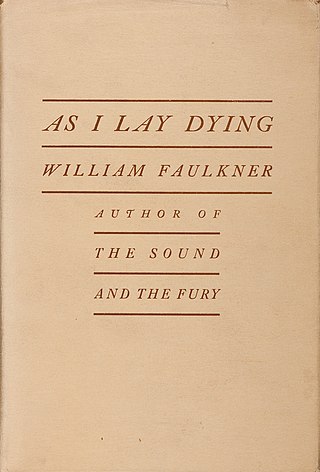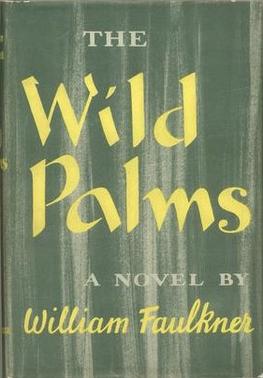Related Research Articles

William Cuthbert Faulkner was an American writer known for his novels and short stories set in the fictional Yoknapatawpha County, based on Lafayette County, Mississippi, where Faulkner spent most of his life. A Nobel laureate, Faulkner is one of the most celebrated writers of American literature and often is considered the greatest writer of Southern literature.

A hamadryad or hamadryas is a Greek mythological being that lives in trees. It is a particular type of dryad which, in turn, is a particular type of nymph. Hamadryads are born bonded to a certain tree on which its life depends. Some maintain that a hamadryad is the tree itself, with a normal dryad being simply the indwelling entity, or spirit, of the tree. If the tree should die, the hamadryad associated with it would die as well. For this reason, both dryads and the other gods would punish mortals who harmed trees.
This article contains information about the literary events and publications of 1962.

The Sound and the Fury is a novel by the American author William Faulkner. It employs several narrative styles, including stream of consciousness. Published in 1929, The Sound and the Fury was Faulkner's fourth novel, and was not immediately successful. In 1931, however, when Faulkner's sixth novel, Sanctuary, was published—a sensationalist story, which Faulkner later said was written only for money—The Sound and the Fury also became commercially successful, and Faulkner began to receive critical attention.
The PEN/Faulkner Award for Fiction is awarded annually by the PEN/Faulkner Foundation to the authors of the year's best works of fiction by living American citizens. The winner receives US$15,000 and each of four runners-up receives US$5000. Finalists read from their works at the presentation ceremony in the Great Hall of the Folger Shakespeare Library in Washington, D.C. The organization claims it to be "the largest peer-juried award in the country." The award was first given in 1981.

As I Lay Dying is a 1930 Southern Gothic novel by American author William Faulkner. Faulkner's fifth novel, it is consistently ranked among the best novels of 20th-century literature. The title is derived from William Marris's 1925 translation of Homer's Odyssey, referencing the similar themes of both works.

If I Forget Thee, Jerusalem is a novel by the American author William Faulkner published in 1939. The novel was originally published under the title The Wild Palms, which is the title of one of the two interwoven stories. This title was chosen by the publishers, Random House, over the objections of Faulkner's choice of a title. Subsequent editions have since been printed under the title If I Forget Thee Jerusalem, and since 2003 it is now usually referred to by both names, with the newer title following the historically first published title and in brackets, to avoid confusion: The Wild Palms [If I Forget Thee, Jerusalem].

William Clark Falkner was a military veteran, businessman, and author in northern Mississippi. He is most notable for the influence he had on the work of his great-grandson, author William Faulkner.
A fable is a story intended to illustrate a moral.

Rowan Oak was the home of author William Faulkner in Oxford, Mississippi. It is a primitive Greek Revival house built in the 1840s by Colonel Robert Sheegog, an Irish immigrant planter from Tennessee. Faulkner purchased the house when it was in disrepair in 1930 and did many of the renovations himself. Other renovations were done in the 1950s. One of its more famous features is the outline of Faulkner's Pulitzer Prize–winning novel A Fable, penciled in graphite and red on the plaster walls of his office. It is now owned and operated by the University of Mississippi as a museum, and is open to visitors year-round.

A Fable is a 1954 novel written by the American author William Faulkner. He spent more than a decade and tremendous effort on it, and aspired for it to be "the best work of my life and maybe of my time". It won the Pulitzer Prize and the National Book Award. Historically, it can be seen as a precursor to Joseph Heller's Catch-22.
Robert Lawson was an American writer and illustrator of children's books. He won the Caldecott Medal for his illustrations in They Were Strong and Good in 1941 and the Newbery award for his short story for Rabbit Hill in 1945.

Julia Glass is an American novelist. Her debut novel, Three Junes, won the National Book Award for Fiction in 2002.

Requiem for a Nun is a work of fiction written by William Faulkner. It is a sequel to Faulkner's early novel Sanctuary, which introduced the characters of Temple Drake, her friend Gowan Stevens, and Gowan's uncle Gavin Stevens. The events in Requiem are set in Faulkner's fictional Yoknapatawpha County and Jackson, Mississippi, in November 1937 and March 1938, eight years after the events of Sanctuary. In Requiem, Temple, now married with a child, must learn to deal with her violent, turbulent past as related in Sanctuary.
Louis Daniel Brodsky was an American poet, short story writer, and Faulkner scholar.
Abigail Faulkner, sometimes called Abigail Faulkner Sr., was an American woman accused of witchcraft during the Salem witch trials in 1692. In the frenzy that followed, Faulkner's sister Elizabeth (Dane) Johnson (1641-1722), her sister-in-law Deliverance Dane, two of her daughters, two of her nieces, and a nephew, would all be accused of witchcraft and arrested. Faulkner was convicted and sentenced to death, but her execution was delayed due to pregnancy. Before she gave birth, Faulkner was pardoned by the governor and released from prison.

Cornell Sidney Franklin (1892–1959) was an American lawyer, judge and politician who served as the chairman of the Shanghai Municipal Council from 1937 to 1940.

Dean Faulkner Wells was an American author, editor, and publisher.
The Wishing Tree, or Wish Tree, may refer to:

The Overstory is a novel by Richard Powers published in 2018 by W. W. Norton & Company. It is Powers' twelfth novel. The book is about nine Americans whose unique life experiences with trees bring them together to address the destruction of forests. Powers was inspired to write the work while teaching at Stanford University, after he encountered giant redwood trees for the first time.
References
- ↑ Popova, Maria (28 Dec 2012). The Strange Story of William Faulkner's Only Children's Book.
{{cite book}}:|newspaper=ignored (help)